- Sugarbaby Watermelon Guide 101: Growing, Care, and More - July 21, 2022
- White Sunflower Varieties Guide with Care and Growing Tips - July 16, 2022
- Black Krim Tomato Guide: Growing, Care, and More! - June 28, 2022
I love my veggie garden, and around two years ago, I decided that I needed to add something sweet to my veggie patch. Someone suggested I try my hand at growing watermelons (I wish I had a Sugar Baby watermelon guide back then!)
I went for the big kind first, and it took up way too much space in my garden, and the waiting period before the fruit was ready was just too long. Enter the Sugar Baby watermelon, and I am in love. These icebox watermelons are bursting with flavor. If I may say so, they make a mean watermelon mojito or (mojito mocktail).
I hope this Sugar Baby watermelon guide will get you as excited as I was to add these beauties to your garden.
Anything that tastes this good will come with a bit of work, patience, and tender loving care. Sugar Baby watermelons are fragile when it comes to watering and pest control, but it’s so worth it when you take that first crispy, sweet bite of deliciousness.
My Bottom Line Up Front
If you are eager to find out if Sugar Baby watermelons are the next big thing (or little thing rather) in your garden, here’s what you need to know:
- A compact heirloom watermelon that fits into your refrigerator easily (as a whole, not cut into slices)
- Has a sweet taste with a beautiful crunchy texture
- The outer rind is dark green with light green stripes, and it has a firm red interior
- Makes amazing smoothies, salads, and carrier oils (to name a few)
- Easy to grow and needs full sunlight and well-draining, moist, and loamy soil
- Ripens within 75-80 days as opposed to 120 days for normal-sized watermelons
What is a Sugar Baby Watermelon?
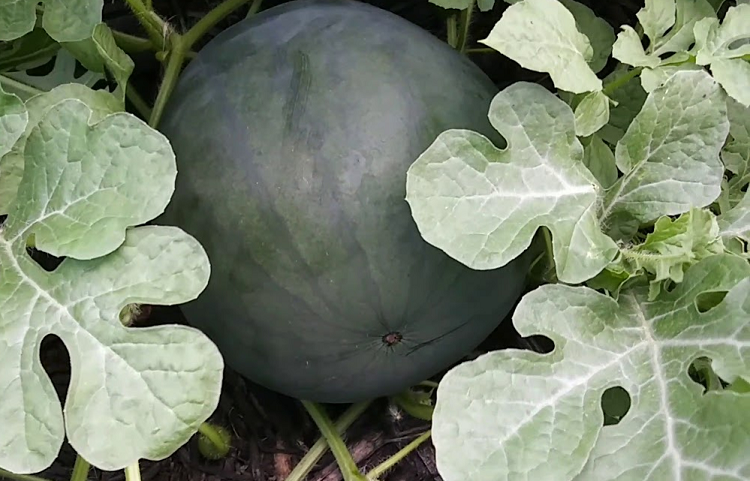
A Sugar Baby watermelon (Citrullus lanatus from the Cucurbitaceae family), also referred to as a “picnic” or “icebox” watermelon, is a compact heirloom watermelon. These short-season fruits ripen in 75 to 80 days (compared to full-sized watermelons that only mature in 120 days – what a long wait, right?!).
Sugar Baby watermelons have thick, dark-green colored rinds with distinct stripes. The rinds protect red-orange flesh and are peppered with large brown seeds. Of all the different types of icebox watermelons, the Sugar Baby watermelon is the most popular, and for a good reason.
The compact vines produce several watermelons, weighing between 6 to 10 pounds per watermelon. Although these fruits are small (72 to 84 inches), they are bursting with some big flavor. The Sugar Baby watermelon is a cultivar (a plant variety produced in cultivation by selective breeding) that originated in Oklahoma and does well in Mediterranean climates.
It was developed by M. Hardin in Geary (a city in Oklahoma). It was introduced by the Woodside Seed Company in 1955. Sugar Baby watermelons attract bees and predatory wasps. If you have rabbits in your garden, these plants are perfectly safe for them to nibble on.
However, you may want to take preventative measures to keep these babies all to yourself. These watermelons are edible and have medicinal purposes. They are high in amino acids and lower the risk of heart attacks.
Other Types of Icebox Watermelons
Icebox watermelons are not just limited to Sugar Baby watermelons (which are by far the sweetest variety). There are many other varieties to choose from. Let’s take a closer look at some of these varieties:
- Yellow Baby Doll is a 6 to 8-pound melon that ripens within 65 to 75 days and has sweet yellow flesh. An excellent option for northern areas with a shorter growing season.
- Doll Babies is grown from a custom seed mix made from two types of icebox melons. These melons ripen within 68 to 80 days and have yellowish or pinky-red flesh.
- Cal Sweet Bush is a 10 to 12-pound melon that grows on a bushy vine. These melons mature within 90 days and produce 2 to 3 melons per vine. They are perfect for growing in containers.
- Tiger Baby is a dark gray-green melon covered with bright green stripes (thus the name Tiger Baby as it looks like the stripes of a young tiger). This sweet melon ripens within 80 to 90 days and has fleshy, bright red meat that is very sweet.
- Bush Sugar Baby is a 6 to 12-pound melon that grows on compact vines that reach 36 to 42 inches. They produce about two melons and ripen within 75 days. They are also great options for growing in containers.
- New Orchid is a melon weighing about 7 to 9 pounds that ripens within 80 days. They have yellow flesh that tastes like sweet sherbet.
What Do Sugar Baby Watermelons Taste Like?
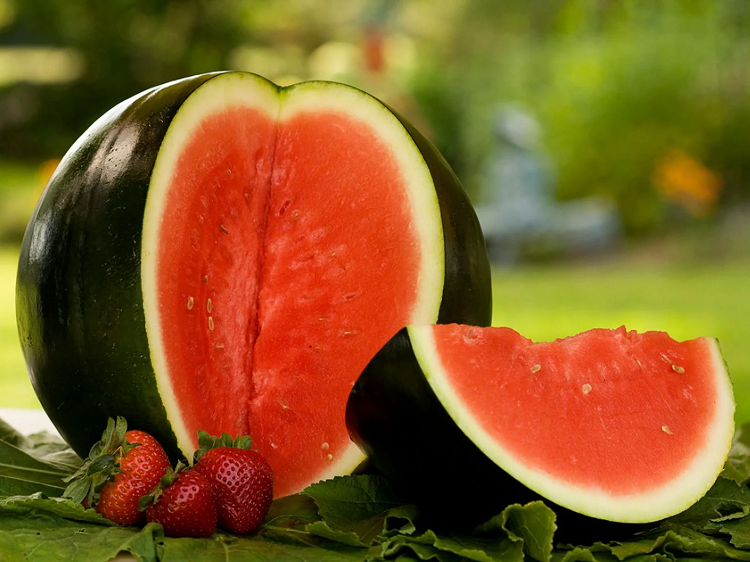
Sugar Baby watermelons are one of the sweetest-tasting watermelons out there. They have a Brix measurement of 10.2, which ranks them as one of the sweetest watermelons. A Brix measurement refers to how high in sugar the watermelon is.
The Sugar Baby watermelon flesh has a juicy, sweet, classic watermelon flavor with a refreshing and crunchy texture. If you want to bring out the taste of the melon, you can add a little squeeze of lime and a sprinkle of sea salt.
I can’t quite explain it, but this enhances your melon’s sweet flavor.
How to Identify a Sugar Baby Watermelon
Identifying a Sugar Baby watermelon can be difficult, especially if you have other icebox varieties in your garden, and they all look pretty similar on the outside. One feature that stands out from different types of watermelons, though, is their compact and small size.
They are part of the icebox family as they can fit into an icebox and are small enough for you to easily carry.
To successfully identify a Sugar Baby watermelon, you need to know what the inside and outside of the watermelon look like. Typically, a Sugar Baby watermelon weighs about 8 pounds with a diameter of around 7 inches.
The rind (skin) has two color varieties. Some have a dark green background with light green stripes, while others have darker stripes. The flesh of the watermelon ranges from a darkish pink to a deep red, and the meat is firm and crispy. Multiple, tiny, dark-colored seeds can be seen inside the flesh.
The Sugar Baby watermelon grows on a vine about 2 to 3 feet long. When the watermelon is ripe, you will notice the tendril closest to the melon turning brown. The spot where your melon touches the ground underneath the melon turns bright yellow.
Where to Buy Sugar Baby Watermelons?
This icebox watermelon is very popular. There are various places and websites where you can order Sugar Baby watermelon seeds.
| Amazon | Website |
|
| Everwilde Farms Inc | Website |
|
| Walmart | Website |
|
| Johnny’s Selected Seeds | Website |
|
| Gurney’s Seed & Nursery Co | Website |
|
| GrowJoy | Website |
|
Sugar Baby watermelons are seasonal and available in summer and fall. You could always add the seedlings and the fruit to your wish list or “notify me” cart when they are unavailable or out of season.
Luckily, the seeds are readily available and relatively easy to find, so you can purchase the seeds and grow your fruit at home.
How to Grow Sugar Baby Watermelon Guide
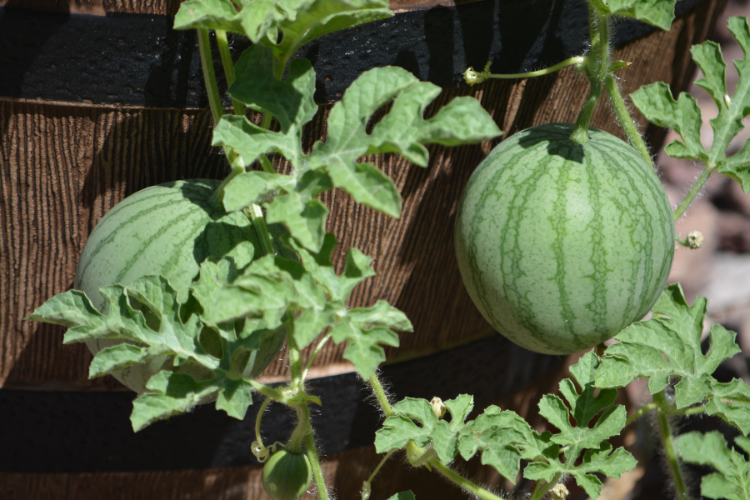
Once you start growing and harvesting these gorgeous watermelons, you will never look back. The beauty of these mini-version watermelons is that they are compact and don’t require much space. They are also super easy to grow and care for.
I’ve compiled an easy step-by-step guide that will provide you with all the growing and caring tips you need to add these wonderful fruits to your garden. Before we start, look at this fabulous “cheat sheet” I put together. This is a must for me, as I have a variety of different fruits and veg in my garden, and I like to make sure I know what each plant requires.
While caring for Sugar Baby watermelons is similar to standard-size watermelons, they require constant drip irrigation. But first, let’s dig into the cheat sheet:
A Cheat Sheet for Caring for Sugar Baby Watermelons
| USDA Plant Hardiness Zone | Zones 3 to 12 (zones 3 to 9 for the best results)
Zones 1 to 2 (will slow the growth and maturation of the plant) |
| Start | Seedlings or seeds |
| Seed life | Four years (if stored in a cool place) |
| Germination | 3 to 10 days at 80 to 90℉ |
| Plant spacing | 18 to 36 inches apart |
| Days to harvest | 75 to 80 days |
| Light | Full sunlight |
| Soil | Rich, well-draining soil (e.g., loamy soil) |
| Water | Keep soil moist but not waterlogged (so avoid overwatering) |
| Fertilizer | ½ cup of 5-10-10 fertilizer above the plant, so the seeds don’t touch the fertilizer
Fertilize every 3-4 weeks, and when transplanted |
| Best companion plants | Basil
Marigold Catnip Tansy Nasturtiums Lettuce Radish Peas Pole beans Bush beans Onions Leeks Chives Alliums Corn Oregano Potatoes Lavender Borage Cosmos Garlic Dill Mint |
Sugar Baby Watermelon Planting Requirements
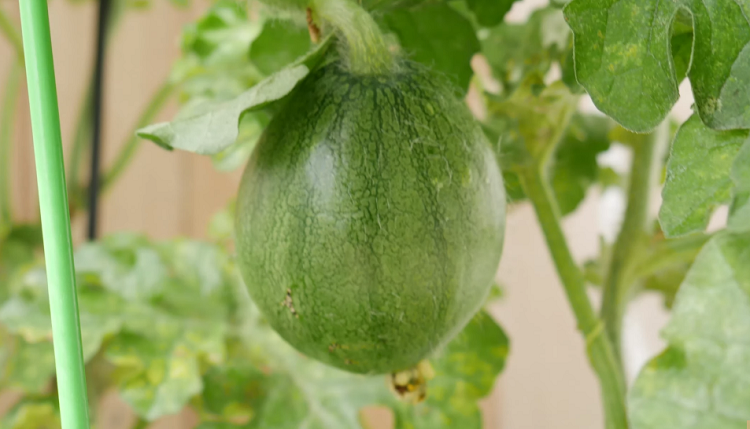
Sugar Baby watermelons thrive in USDA plant hardiness zones 2 to 12 or warmer climates with moderate humidity. These watermelons tolerate heat more than extreme cold and don’t handle frost. These watermelons also don’t tolerate extreme heat. In the cooler months, you can plant the seeds indoors and transplant them into the garden as the temperatures warm up.
The Sugar Baby watermelon can be started indoors for around 3 to 4 weeks before the season’s last frost, as they require a longer growing season.
Sugar Baby Watermelon Planting and Transplanting Requirements
A Sugar Baby watermelon plant can produce up to 5 melons per vine, with a minimum of 2 melons. The first melon to ripen is usually the largest. Toward the end of the season, the smaller melons will ripen.
Tip: The watermelon vines grow pretty quickly and need regular pruning to keep them under control.
What You Need
Before you start planting your Sugar Baby watermelon seeds or transplanting your seedlings, you will need:
- Potting soil or seed starting mix
- A good quality compost
- Liquid dish soap
- 4-inch peat pots
- Store-bought or homemade mulch
- Water mister or spray bottle with a fine spray setting
- Small garden spade
- Garden hose
- Bucket or jar
- Wooden pallets or boards
- Fabric row cover (or pantihose works well too)
- Wooden trellis (optional)
- Heat mat (optional)
- Scissors
Start the Planting Process Indoors
Because Sugar Baby watermelons need a longer growing season, you should always start your planting process indoors. I have personally found this to be very successful in securing a successful harvest. Plant 3 seeds (maximum) 1 inch deep in the peat pots filled with potting soil or a seed-starting medium. This is best done around six weeks before you plan to transplant them outdoors.
Place your pots on a windowsill or spot that gets full sunlight. Keep the potting soil moist with your mister or spray bottle until germination takes place at around 3 to 10 days. The soil should remain between 80 to 90℉, and you can use a heat mat if the temperature is too cool.
Once the seeds have successfully germinated, lower the temperature of the soil to about 70℉ for around 1 to 2 weeks. Don’t water the seedlings as often, and begin thinning out the plants in the peat pots. Place each seedling in its own pot about 2 to 3 weeks before you plan to transplant them.
When you notice the first leaves sprouting, start tapering off the water even more, but be careful not to allow your seedling to wither from too little water. Now it’s time to prepare your watermelon patch while they grow stronger.
Tip: Expose your seedlings to the outdoors for short periods so the transplanting process is more successful and they become more resilient.
Prepare the Watermelon Patch
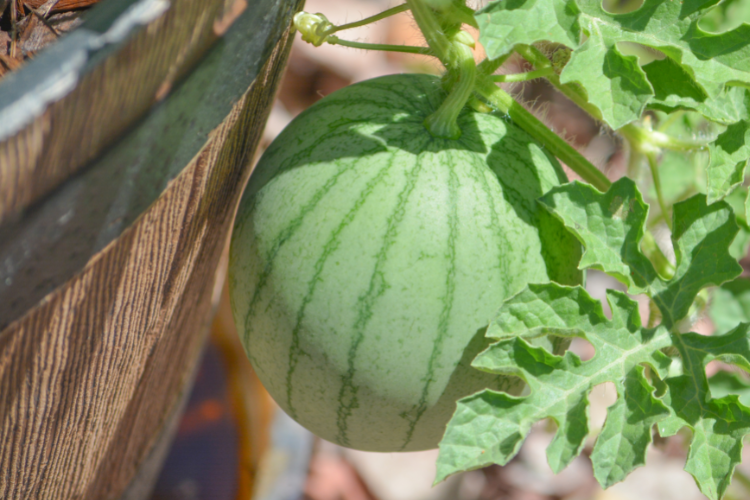
Preparing your watermelon patch doesn’t require too much work. Simply use a spade to work in a 4-inch layer of good-quality compost. You can work the compost about 8 inches deep into the soil. You must create a mound for every three watermelons you plan to grow. Ideally, these mounds should be about 24 inches in diameter. If you plan to plant more than three vines, you need to space them about 4 to 6 feet apart.
Make sure your watermelon patch has good soil that is high in organic matter, preferably with a pH of 6.5 to 7.5. The watermelons will also need the soil to be well-draining and warm. Use fabric row covers to increase the soil warming. I found that lining my watermelon mounds with black plastic mulch warmed up the soil.
Transplant the Seedlings
Once the seedlings have been exposed to the outdoors and your mounds are ready, transplant the Sugar Baby watermelon seedlings. Remember, transplants are fragile, and the roots are sensitive to disturbances.
Gently plant three Sugar Baby watermelon seedlings into each mound.
Tip: If possible, I recommend transplanting the seedlings during an overcast day to prevent scorching.
Place a 2-inch layer of mulch between the seedlings and the mounds to help keep the weeds away and maintain some warmth in the soil. Water the seedlings and avoid watering the vines, as watermelons are susceptible to developing fungal diseases caused by wet leaves.
Use a garden hose or drip irrigation system to keep the soil moist and provide the vines with a constant water supply. Add about 1 inch of compost around each Sugar Baby plant to provide nutrients that will soak into the soil.
Place the developing fruit on wooden boards to prevent rot caused by the melons lying directly on the ground. This also keeps them away from pesky soil-dwelling insects. If you are growing your melons on a trellis, you can make a sling from pantyhose to support your growing melons. Trellising is excellent for air circulation and reduces the chances of foliage disease.
Always ensure your melons don’t dry out during the growing season. On the other hand, don’t overwater your plants as it will negatively affect their flavor when they ripen. As a rule of thumb, keep the soil moist but not soggy.
Sugar Baby Watermelon Pollinating Requirements
These cute heirloom watermelons are open-pollinated, which means they’re pollinated naturally by bees, wasps, and other insects seeking nectar. Because this is a natural phenomenon, there is not much required of you. Mother Nature does all the work.
Sugar Baby watermelon plants have yellow female and male flowers on their vines. The bees (or other nectar-seeking insects) distribute the pollen from the male plants to the female plants, which results in pollination and fruit development.
If there was a lot of rain or a pesticide was used near the watermelons, the bees would stay away, and pollination would not occur. If the plant is diseased, then the bees will also be deterred.
There is no need to worry if this is the case, as there is also an option to increase pollination by hand pollinating. I found a method that works wonders for me. You need at least one male and one female flower to hand pollinate a melon.
First, check out how to identify the male and female flowers:
- The female flower is identified by a small sticky bump at the base of the flowers, known as a stigma
- The male flower has a stamen (pollen-covered stalk) that sticks up in the center of the flower
Let’s take a quick look at how to hand-pollinate your watermelon:
- Make sure your plant has male and female flowers on it and that both flowers are open (indicating that they are ready for pollination).
- Once the flowers are open, you only have a day to hand pollinate. So speed is encouraged.
- Use a small paintbrush and rub it along the male flowers’ stamen. Make sure the paintbrush is covered with pollen.
- Paint the stigma of the female flower with the paintbrush.
- You will need to pick up the pollen from the male flower each time.
Another option is to pick the male flower from the plant, strip away the petals, and gently tap the stamen on the female flower’s stigma to coat it with pollen evenly.
Sugar Baby Watermelon Light Requirements
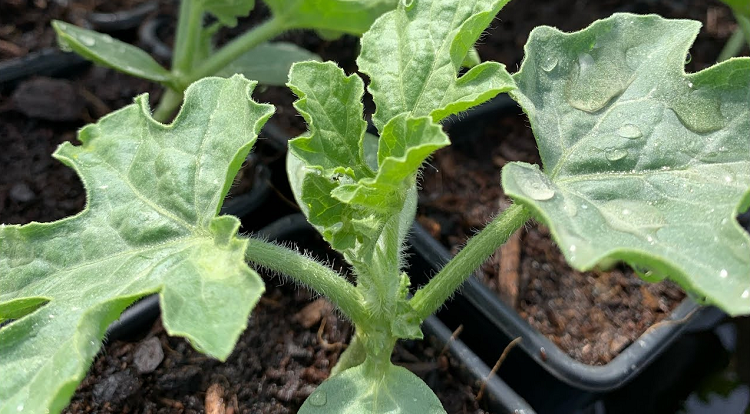
Sugar Baby watermelons thrive in full sunlight, requiring at least 8 hours of sun exposure a day. So it’s vital to plant your watermelons in a spot with enough sunlight and not surrounded by trees that will provide unwanted shade.
Sugar Baby Watermelon Soil Requirements
These small melons are quite fussy when it comes to the type of soil they need. Ensure the soil is rich and well-draining. If the soil isn’t up to scratch, you can improve the quality by adding compost or composted manure to it.
The soil must maintain a pH of 6.5 to 7.5.
Sugar Baby Watermelon Water Requirements
When it comes to water requirements for Sugar Baby watermelons, it’s important not to overwater them. Overwatering leads to fungus development and a “watered down” flavor and richness from your ripe melon. These melons require 1 to 2 inches of water every week, which amounts to 16 gallons. Keep the soil moist until your fruit reaches its full size using a spray bottle or a garden hose.
Try not to water the vines or leaves of your plant, as this will cause foliage fungus, which can lead to rot.
Sugar Baby Watermelon Fertilizer Requirements
Sugar Baby watermelons have no set fertilizer requirements and fertilizing depends on the condition of the soil and at what stage the watermelon is at in its growth. The best fertilizer for seeds and seedlings is one that has a nitrogen base.
Once the plant starts flowering, you can use phosphorus and potassium-based fertilizer for optimal fruit production. If you can’t do a soil test, be safe and use a 5-10-10 ratio at the rate of 15 pounds per 500 feet. This is the best ratio to avoid nitrogen burn.
The fertilizer can be mixed into the top 6 inches of the soil. I fertilized my watermelons when I transplanted them into my garden, and then I fertilized once every 3-4 weeks (if necessary).
Sugar Baby Watermelon Harvesting Requirements
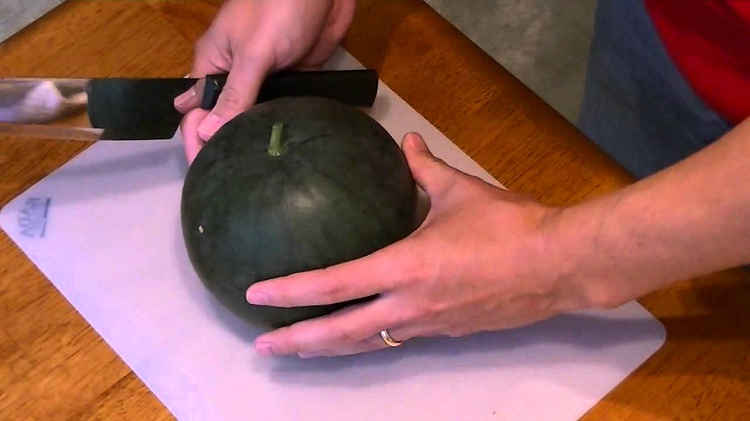
Harvesting Sugar Baby watermelons is a little more tricky than other fruits. You need to ensure the melons are ripe, so don’t harvest them too early. I find the best way to check if your melon is ripe is to roll it over gently and to pay attention to the spot where the melon touched the ground.
If your melon is ripe, that spot should have a pale yellow color. Take note of the tendrils around the melon closest to the main vine. The tendril closest to it will appear dead and dried if the melon is ripe. If you store your watermelon correctly in the refrigerator, it can be kept for up to 2 weeks. Be wary of watermelon if its flesh turns a bright red and splits, as this indicates that the watermelon has spoiled.
Saving the Sugar Baby Watermelon Seeds
There is no need to keep buying seeds for your next crop of watermelon as it’s very easy to simply collect the seeds and use them when it’s time to plant again.
To save your Sugar Baby watermelon seeds:
- Cut a ripe watermelon down the middle.
- Scoop out the seeds and the pulp.
- Place the pulp and seeds into a wire mesh sieve and run some water over it.
- Gently rub the seeds and the pulp against the mesh to loosen any stringy fibers sticking to the seeds.
- Place the seeds in a bowl of cool water and stir.
- Any seeds that float to the top are sterile and hollow inside. Throw these away.
- Keep stirring the water until no more seeds are floating to the top.
- Drain the water from the remaining seeds that didn’t float to the top.
- Line a baking pan with wax paper and spread the seeds in a single layer.
- Place the pan in the sun for the seeds to air dry.
- Stir the seeds now and then to make sure all sides receive fresh air, which will help dry them out evenly.
- Once the seeds have been in the sun for a whole day, you can leave them in the house to dry for another week or two.
- Gently move the seeds around daily to encourage even drying.
Seed Tip: Ensure your seeds are thoroughly dry before storage, as melons have thick seeds that hold water and can lead to them rotting.
Common Sugar Baby Watermelon Problems and Solutions
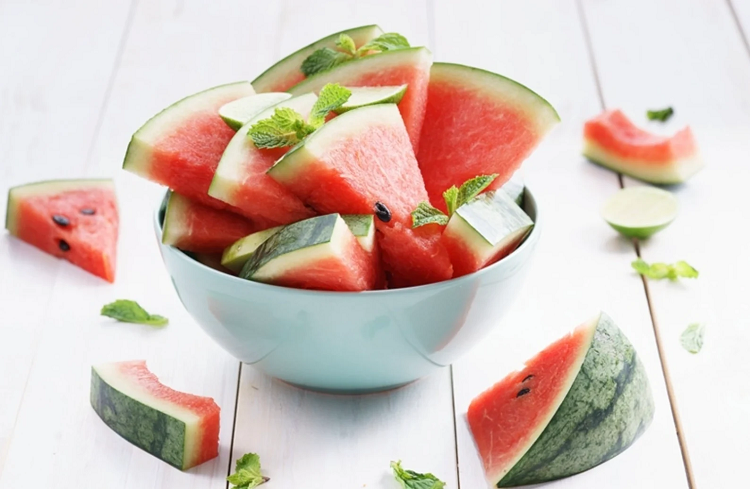
Unfortunately, several problems can arise when growing Sugar Baby watermelons, ranging from fungus, disease, and insect infestation. Sometimes, your plant and fruit can sustain damage from simply overwatering the vines. Other problems, such as aphids, are a little more frustrating.
Over these past two years, I have learned how to handle quite a few of these problems, and the solutions are pretty simple. Here are a few common problems I have come across. I’ve included solutions to help you prevent or treat the problem when things go wrong with your Sugar Baby watermelons:
|
Problem |
Symptoms |
Solution |
|
Fungus |
||
| Pythium aphanidermatum (also known as damping-off) |
|
|
| Fusarium wilt |
|
|
|
Environmental Issues |
||
| Overwatering |
|
|
| Not enough pollination |
|
|
|
Pests |
||
|
|
|
FAQs
Answer: Besides being super tasty and sweet, Sugar Baby watermelons are very good for you. They contain high levels of healthy antioxidants, which play a positive role in fighting against heart disease. These watermelons also have bone-strengthening potassium, which is also very good for you.
Answer: Sugar Baby watermelon makes a lovely, thirst-quenching snack on a hot summer’s day. You can cut it into slices and serve it as a salad with olives, feta, and a dash of lemon. Making watermelon oil is fantastic to use as a carrier oil. You can also make healthy smoothies and frozen sorbet out of the sweet, fleshy pulp.
Answer: Sugar Baby watermelons can be grown in pots. The perfect container would be a biodegradable container that has good drainage. The container should ideally be able to hold 5 to 15 gallons.
My Final Sugar Baby Watermelon Thoughts
I am so excited about these Sugar Baby watermelons, and they rank number one on my list out of all the cultivars and varieties of watermelon I have grown. Because of their compact size, there was absolutely no waste (and nothing left to store) once my son and I were done snacking on one. This suits me perfectly!
You must keep a careful eye on your melons, as they are pretty fragile when it comes to over or underwatering. Also, look out for fungus or signs that your plant is not being pollinated successfully.
I had tried both planting methods when I planted my Sugar Baby melons, and my go-to is still to grow them indoors first, and once they are strong seedlings, I move them into my garden. Knock on wood; I have had a good crop every year.
If you enjoyed this guide and would like to learn about other lovely watermelon varieties, check out our helpful guides on the:

